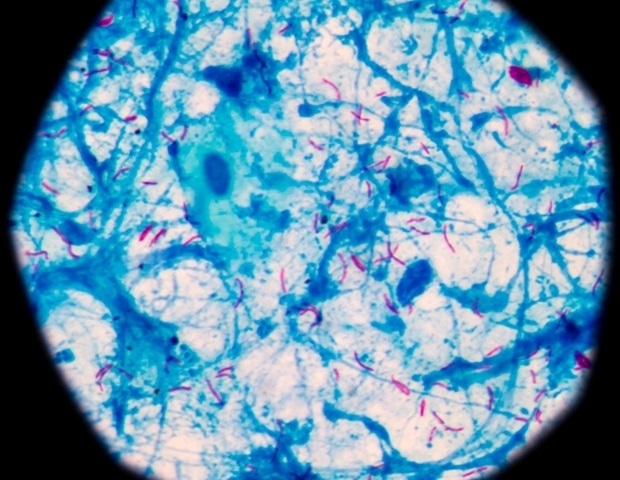
As of early 2025, tuberculosis instances are rising within the U.S. This illness, usually shortened to TB, causes important lung injury and, if not handled, is nearly at all times deadly. World TB Day on March 24 raises consciousness concerning the illness and commemorates Robert Koch’s discovery of the supply bacterium Mycobacterium tuberculosis. Greater than a century later, scientists proceed refining TB analysis strategies and therapy methods, a few of that are in these 4 ACS journal articles. Reporters can request free entry to those papers by emailing [email protected].
-
Fluorescence for a quicker TB analysis. At present, testing saliva samples for M. tuberculosis is time-consuming due to the bacterium’s sluggish development and resistance to stains utilized in imaging. To develop a quicker methodology, researchers focused a protein that the bacterium makes use of to steal iron ions from its host’s cells. In a research printed in ACS Central Science, the group explains methods to label the iron-transporter protein with a fluorescent tag, which activates after releasing the iron contained in the M. tuberculosis cells. In separate exams on saliva from 11 individuals identified with TB, the fluorescence approach recognized infectious ranges of the bacterium inside 10 minutes.
-
White blood cell-focused M. tuberculosis remedy. A kind of white blood cell known as a macrophage will get taken over throughout a tuberculosis an infection, changing into an incubator for the pathogen. So, researchers report in ACS Infectious Illnesses that they’ve developed sugar-coated nanoparticles that get absorbed by contaminated macrophages. And as soon as inside, the nanoparticles interrupted crucial mobile pathways and prompted the broken cells to be recycled. In contaminated mice, 6 weeks of nanoparticle therapy considerably decreased the quantity of M. tuberculosis within the lungs.
-
A possible nasal therapy for tuberculous meningitis. If M. tuberculosis reaches cerebrospinal fluid, the consequence may be tuberculous meningitis – a life-threatening irritation round an individual’s mind and spinal twine. To get the TB drug clofazimine throughout the blood-brain barrier, researchers have encapsulated it inside tiny particles and created a nasal spray. In response to their research in ACS infectious Illnesses, the spray did not adversely have an effect on mice with tuberculous meningitis. A 4-week therapy considerably decreased the bacterial burden throughout the animals’ brains and lungs in comparison with untreated mice.
-
Gentle-activated particles inactivate micro organism. Many new TB instances are multidrug resistant. So, a analysis group needed to enhance therapy efficacy and cut back the danger of additional antimicrobial resistance by making a photoreactive remedy. They encapsulated light-activated particles inside nanometer-wide spheres. When the nanospheres had been injected into mice, crimson laser mild triggered the particles to provide reactive oxygen species that inactivated Mycobacterium marinum, a bacterium that causes TB-like sickness in fish. The preliminary animal research outcomes are printed in ACS Omega.
Moreover in March 2025, ACS Webinars and ACS Publications co-hosted a digital occasion, “Disrupt & Destroy: Ravenous Tuberculosis with Smarter Science,” about modern drug methods and cutting-edge TB analysis. The webinar is offered to look at on demand.
Supply:
Journal references:
- Ni, D., et al. (2025). Insights into IrtAB: Iron Transport Facilitates Ultrasensitive Detection of Mycobacteria in Each Mobile and Medical Environments. ACS Central Science. doi.org/10.1021/acscentsci.4c00676.
- Bekale, R. B., et al. (2025). Immunomodulatory Nanoparticles Induce Autophagy in Macrophages and Scale back Mycobacterium tuberculosis Burden within the Lungs of Mice. ACS Infectious Illnesses. doi.org/10.1021/acsinfecdis.4c00713.
- Jadhav, Okay., et al. (2025). Pharmacokinetic and Pharmacodynamics of Clofazimine Nano-in-Microparticles: Enhanced Mind Supply and CNS Tuberculosis Amelioration through Intranasal Administration. ACS Infectious Illnesses. doi.org/10.1021/acsinfecdis.4c00767.
- Wang, H., et al. (2025). Uptake of Biomimetic Nanovesicles by Granuloma for Photodynamic Remedy of Tuberculosis. ACS Omega. doi.org/10.1021/acsomega.4c08127.